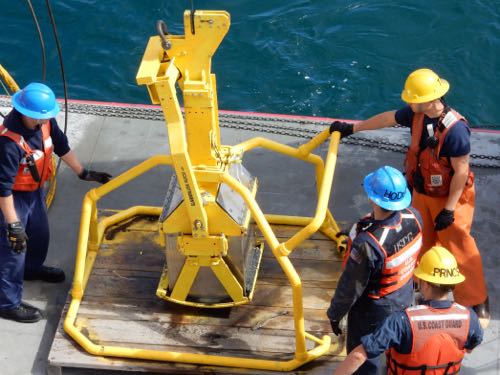I sat on an overturned bucket on the fantail of an icebreaker, in the Arctic, sieving mud from a depth of 1,000 meters. Even though it was late, there was full daylight. It was totally out of the realm of anything I ever expected to be doing in the summer of 2016! Little did I know that a day later I would be doing the same thing in 30 knot winds driving snow and sleet into my face.
Fruits of the Box Corer
We were sieving the results of a box corer deployment. The box corer is the big shovel-like instrument used to collect benthic samples. When the device was brought back onto the ship, water was siphoned off the top of the mud, and then the mud was divided into sections for different types of preparation and study. I was sieving the top 5 centimeters of mud from one of the sections. Sieving means washing the mud through a fine mesh screen using a hose connected to seawater. All of this is done in brisk wind, on a moving boat, wearing hardhat, mustang suit, and insulated rubber gloves.
The tiny organisms remaining in the screen are then transferred to a specimen jar for preservation and transport back to the lab where organisms will be sorted, counted, and identified to give a picture of benthic biodiversity in the test area. I was surprised at how fine the sediment particles were and how sticky the mud/clay felt.
 Sieving arctic mud.
Sieving arctic mud.
Note the full daylight and that my glasses have changed color even though it is late at night.
Question and Answer
Mystery Photo
 Can you identify the device shown in this photo?
Can you identify the device shown in this photo?
What piece of equipment is shown in this photo? Hint: Have you been reading past journals?
Answer From Last Q: Great answer, Michelle! The chlorophyll max for this test was the 60-70 meter range. I took samples of water from the bottle that corresponded to that peak.


Comments